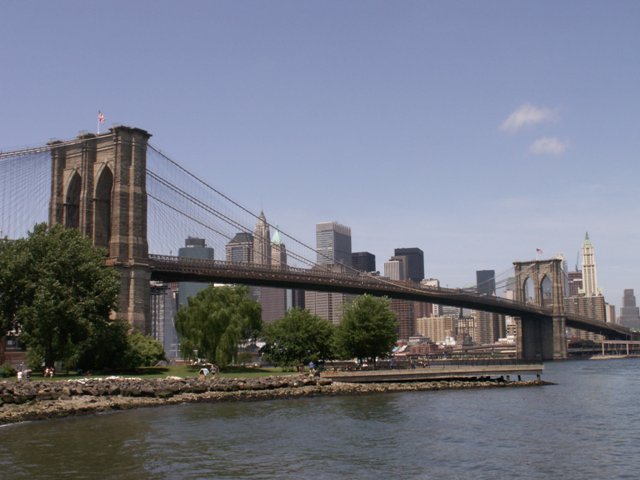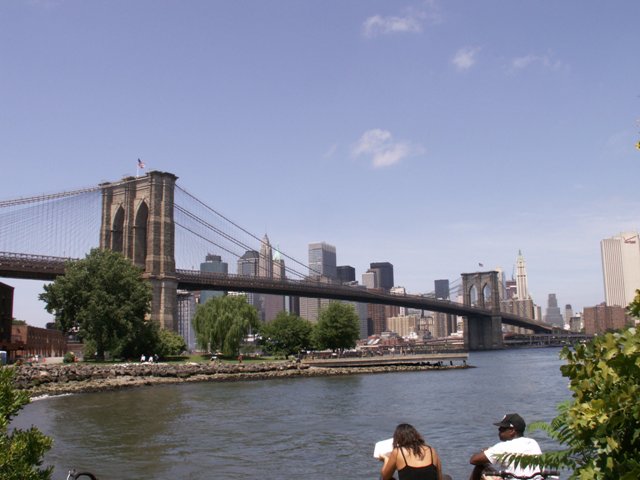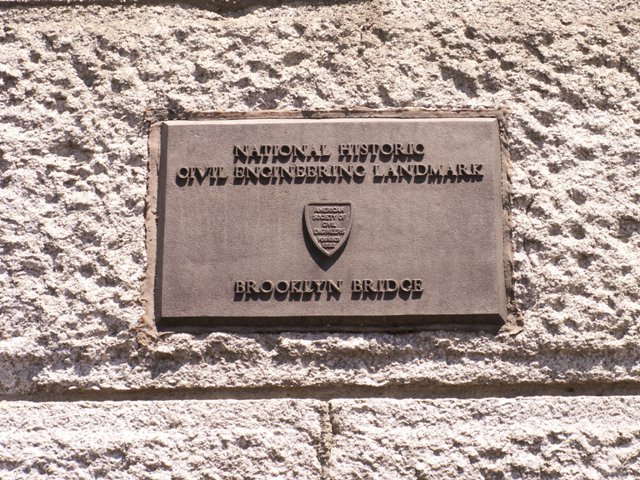We Recommend:
Bach Steel - Experts at historic truss bridge restoration.
BridgeHunter.com Phase 1 is released to the public! - Visit Now
Brooklyn Bridge

Primary Photographer(s): Nathan Holth and Rick McOmber
Bridge Documented: July 12, 2008
New York: Brooklyn, New York and Manhattan, New York: United States
Metal Through Truss Stiffening Wire Cable Suspension, Fixed and Approach Spans: Stone Semicircular Deck Arch, Fixed
1883 By Builder/Contractor: New York Bridge Company, Edge Moor Iron Company, J. Lloyd Haigh, and Others and Engineer/Design: Washington Augustus Roebling, John Augustus Roebling, and Others
1994
1,595.5 Feet (486.3 Meters)
5,989.0 Feet (1825.4 Meters)
59.7 Feet (18.2 Meters)
3 Main Span(s) and 72 Approach Span(s)
2240019

View Information About HSR Ratings
Bridge Documentation
View Archived National Bridge Inventory Report - Has Additional Details and Evaluation
View Historic American Engineering Record (HAER) Documentation For This Bridge
HAER Drawings, PDF - HAER Data Pages, PDF
View the National Register of Historic Places Nomination Form For This Historic Bridge
| Additional Technical Facts |
| Structure Length Between Anchorages | Clearance Above Water At Towers | Tower Height Above Water | Maximum Tower Width |
| 3455.5 Feet (1053.2 Meters) | 110 Feet (33.5 Meters) | 276.5 Feet (84.3 Meters) | 140 Feet (42.7 Meters) |
The Brooklyn Bridge has been called the most influential bridge in the history of the United States. It is also, perhaps alongside the Golden Gate Bridge, the most well-known and recognizable bridge in the United States as well. Indeed it is one of the few bridges that is well-known around the world. It is an unheard-of marvel of engineering for its time, and was the longest bridge in the world when built, a record it held for 20 years. Today the bridge remains an impressive monument that continues to draw countless residents and visitors to view its elaborate cable and truss system, which is supported by truly massive stone towers of a size that can only be truly appreciated when seen in person.
The bridge features relatively high integrity given its age and the fact it continues to carry an incredible amount of traffic in the largest city in the U.S. However, there are numerous alterations to the details including addition/replacement of rivets (with bolts), cables, etc. The most extensive alteration was completed in 1954, and the stiffening trusses were significantly reconfigured at this time. However despite these changes, much of the truss and stone materials remains original, and the overall design and function of the bridge remains intact.
Its history is extremely well-documented in numerous websites
and texts. For a short history, check out the National Register nomination form
link above. Additionally, a number of additional resource links are available
below. The 1883 Report of the Accountants of the New York
and Brooklyn
Bridge (available below) may sound bland, but the first and last parts of
the enormous book are perhaps the best source of information on the fabricators
and suppliers of materials for the bridge. The New York and Brooklyn
Bridge Company, whose name was later shortened to New York Bridge Company, was
organized to handle the operations, funds, and logistical organization needed to
construct and manage such an immense bridge project. Most unusually, this New
York Bridge Company also directly hired workers and conducted the operation of
the on-site bridge construction and erection, meaning that there was not a hired
contractor for erection and construction work in the usual sense. The New York Bridge Company
did solicit bids and award contracts for fabrication and materials supply. A few
of the noteworthy contracts included a contract to J. Lloyd Haigh for the
main wire cable. J. Lloyd Haigh was later at the center of some controversy as
some of the cable the company supplied was faulty. John A Roebling Sons Company
supplied the main cable exterior wrapping, but not the main cable structural
wire itself, that work being contracted to J. Lloyd Haigh. The Edge Moor Iron
Company fabricated the truss superstructure for the suspended spans. Edge Moor
Iron Company later developed a bridge-dedicated offshoot called Edge Moor Bridge
Works. Other contractors who would be familiar to bridge historians thanks to
prolific bridge work elsewhere, that had more minor contracts for various
aspects of the Brooklyn Bridge work included the Pittsburgh Bridge Company, the
Keystone Bridge Company, and the Passaic Rolling Mill Company.
A detailed research analysis of this famous bridge is currently outside of the goals of HistoricBridges.org. Instead, please enjoy the additional resources linked to below. However, HistoricBridges.org is proud to provide one of the largest collections of photos, particularly detail photos, of this magnificent bridge. Included in the photo gallery are details of the connections, plaques, and beautiful overviews of the bridge as seen from the new park constructed in Brooklyn around the bridge, as well as views seen as one walks on the bridge's pedestrian (upper) deck.
Above: Early 20th Century Photos of Bridge. Source: Library of Congress
Additional Resources
View a Historical Book Detailing History of Brooklyn Bridge
View A Historical Pamphlet With Images and Short History of Brooklyn Bridge
View An 1870 Report of the Chief Engineer John Roebling On Brooklyn Bridge
View An 1883 Report of the Accountants of the New York and Brooklyn Bridge
View A Historical Biography of the Roeblings
View The Official Opening Ceremonies Guide For The Brooklyn Bridge
View A Historical Book Discussing the 1954 Rehab
View Historical Article About 1954 Rehab
![]()
Photo Galleries and Videos: Brooklyn Bridge
Structure Overview
Original / Full Size PhotosA collection of overview photos that show the bridge as a whole and general areas of the bridge. This gallery offers photos in the highest available resolution and file size in a touch-friendly popup viewer.
Alternatively, Browse Without Using Viewer
![]()
Structure Details
Original / Full Size PhotosA collection of detail photos that document the parts, construction, and condition of the bridge. This gallery offers photos in the highest available resolution and file size in a touch-friendly popup viewer.
Alternatively, Browse Without Using Viewer
![]()
Structure Overview
Mobile Optimized PhotosA collection of overview photos that show the bridge as a whole and general areas of the bridge. This gallery features data-friendly, fast-loading photos in a touch-friendly popup viewer.
Alternatively, Browse Without Using Viewer
![]()
Structure Details
Mobile Optimized PhotosA collection of detail photos that document the parts, construction, and condition of the bridge. This gallery features data-friendly, fast-loading photos in a touch-friendly popup viewer.
Alternatively, Browse Without Using Viewer
![]()
Maps and Links: Brooklyn Bridge
Coordinates (Latitude, Longitude):
Search For Additional Bridge Listings:
Bridgehunter.com: View listed bridges within 0.5 miles (0.8 kilometers) of this bridge.
Bridgehunter.com: View listed bridges within 10 miles (16 kilometers) of this bridge.
Additional Maps:
Google Streetview (If Available)
GeoHack (Additional Links and Coordinates)
Apple Maps (Via DuckDuckGo Search)
Apple Maps (Apple devices only)
Android: Open Location In Your Map or GPS App
Flickr Gallery (Find Nearby Photos)
Wikimedia Commons (Find Nearby Photos)
Directions Via Sygic For Android
Directions Via Sygic For iOS and Android Dolphin Browser
USGS National Map (United States Only)
Historical USGS Topo Maps (United States Only)
Historic Aerials (United States Only)
CalTopo Maps (United States Only)









